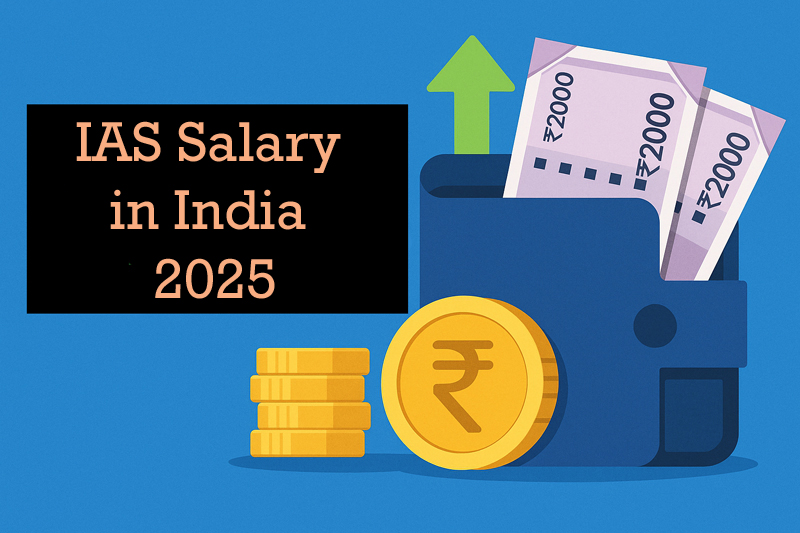The Indian Administrative Service (IAS) is one of the most prestigious career paths in India, attracting thousands of aspirants each year. Beyond its reputation for power and responsibility, the IAS salary structure is a significant draw for candidates. This blog provides a comprehensive, updated guide to IAS salaries in 2025, including pay scales, allowances, perks, and career progression, optimized for those researching this coveted career.
What is the IAS Salary Structure?
The salary of an IAS officer is governed by the 7th Central Pay Commission (CPC), implemented in 2016 and still applicable in 2025. The salary comprises a basic pay, grade pay (for certain levels), and various allowances. The exact salary depends on the officer’s rank, years of service, and posting location.
IAS Salary: Pay Scale by Rank
IAS officers progress through various ranks, from Sub-Divisional Magistrate (SDM) to Cabinet Secretary, with salaries increasing at each level. Below is a breakdown of the approximate monthly salary (basic pay + allowances) for key IAS ranks in 2025:
| Rank/Position | Pay Level | Basic Pay (INR) | Approx. Total Salary (INR) |
|---|---|---|---|
| Sub-Divisional Magistrate (SDM) | 10 | 56,100 | 80,000–1,00,000 |
| District Magistrate (DM) | 11–12 | 67,700–78,800 | 1,00,000–1,40,000 |
| Joint Secretary | 13 | 1,18,500 | 1,80,000–2,20,000 |
| Additional Secretary | 14 | 1,44,200 | 2,20,000–2,50,000 |
| Secretary | 15 | 1,82,200 | 2,50,000–3,00,000 |
| Cabinet Secretary | 18 | 2,50,000 | 3,50,000–4,00,000 |
Note: Total salary includes allowances like Dearness Allowance (DA), House Rent Allowance (HRA), and others, which vary by location and inflation adjustments. As of 2025, DA is approximately 50% of basic pay, subject to periodic revisions.
Key Allowances for IAS Officers
In addition to basic pay, IAS officers receive a range of allowances that significantly boost their income. These include:
- Dearness Allowance (DA): Adjusted biannually to offset inflation. In 2025, DA is around 50% of the basic pay.
- House Rent Allowance (HRA): Varies by city—24% of basic pay for metro cities (e.g., Delhi, Mumbai), 16% for Tier-2 cities, and 8% for rural areas. Officers in government accommodations may not receive HRA.
- Travel Allowance (TA): Covers official travel expenses, including airfare for senior officers.
- Medical Allowance: Reimbursement for medical expenses for the officer and their family.
- Other Perks: Includes subsidized electricity, official vehicles, security, and domestic help, depending on the posting.
These allowances can increase the total monthly compensation by 30–50%, making the IAS salary package highly attractive.
IAS Salary During Training
During the training period at the Lal Bahadur Shastri National Academy of Administration (LBSNAA) in Mussoorie, IAS probationers receive a fixed stipend. In 2025, the approximate salary during training is:
- Basic Pay: INR 56,100 (Pay Level 10)
- Total Stipend (after deductions): INR 45,000–50,000 per month
Post-training, once officers are posted as SDMs, their salary increases with full allowances.
IAS Career Progression and Salary Growth
The IAS offers a structured career path with regular promotions based on years of service and performance. Here’s a typical progression:
- Sub-Divisional Magistrate (SDM): Entry-level, 2–4 years.
- District Magistrate (DM)/Collector: After 5–7 years.
- Divisional Commissioner: After 10–15 years.
- Joint Secretary/Additional Secretary: After 15–20 years.
- Secretary/Cabinet Secretary: Senior-most positions, reached after 25–30 years.
With each promotion, the pay level and allowances increase, leading to significant salary growth over time. For instance, an IAS officer starting at INR 80,000/month as an SDM could earn over INR 3,00,000/month as a Secretary.
Additional Perks of Being an IAS Officer
Beyond salary, IAS officers enjoy numerous non-monetary benefits:
- Government Accommodation: Spacious bungalows or apartments in prime locations.
- Official Vehicle and Driver: Provided for official and personal use.
- Security: Armed security for senior officers or those in sensitive postings.
- Pension and Retirement Benefits: Under the National Pension System (NPS), ensuring financial security post-retirement.
- Study Leave: Opportunities for higher education (e.g., at prestigious institutions like Harvard or Oxford) with partial sponsorship.
These perks enhance the overall appeal of the IAS as a career choice.
Factors Affecting IAS Salary
Several factors influence an IAS officer’s take-home salary:
- Posting Location: Metro cities offer higher HRA, while rural postings may include additional hardship allowances.
- Years of Service: Longer service leads to higher pay levels and increments.
- Inflation Adjustments: DA revisions ensure salaries keep pace with rising costs.
- Special Postings: Officers in challenging areas (e.g., Northeast or Naxal-affected regions) may receive special allowances.
Why Choose an IAS Career?
While the IAS salary is lucrative, the role offers more than just financial rewards. IAS officers play a pivotal role in policy-making, governance, and nation-building. The job provides:
- Job Security: A stable government position with minimal risk of layoffs.
- Social Impact: Direct influence on public welfare and development.
- Prestige and Power: High societal respect and authority in decision-making.
How to Become an IAS Officer?
To earn an IAS salary, candidates must clear the UPSC Civil Services Examination (CSE), one of India’s toughest competitive exams. The process involves:
- Preliminary Exam: Objective-type screening test.
- Mains Exam: Written exam with nine papers.
- Interview: Personality test assessing suitability for the role.
Eligibility includes a bachelor’s degree from a recognized university and an age limit of 21–32 years (with relaxations for reserved categories).

Hi, I’m Varun Pathak, the founder of TheSarkariNaukri.com—a dedicated platform for the latest updates on government jobs (Sarkari Naukri) in India. With years of experience curating reliable information on job vacancies, admit cards, exam results, and preparation strategies, I help thousands of aspirants navigate the competitive world of public sector opportunities. Passionate about job security, career growth, and empowering freshers for roles like IAS, IPS, and PSU positions, I update the site regularly with actionable insights for 2025 and beyond. Let’s connect to turn your career dreams into reality!
